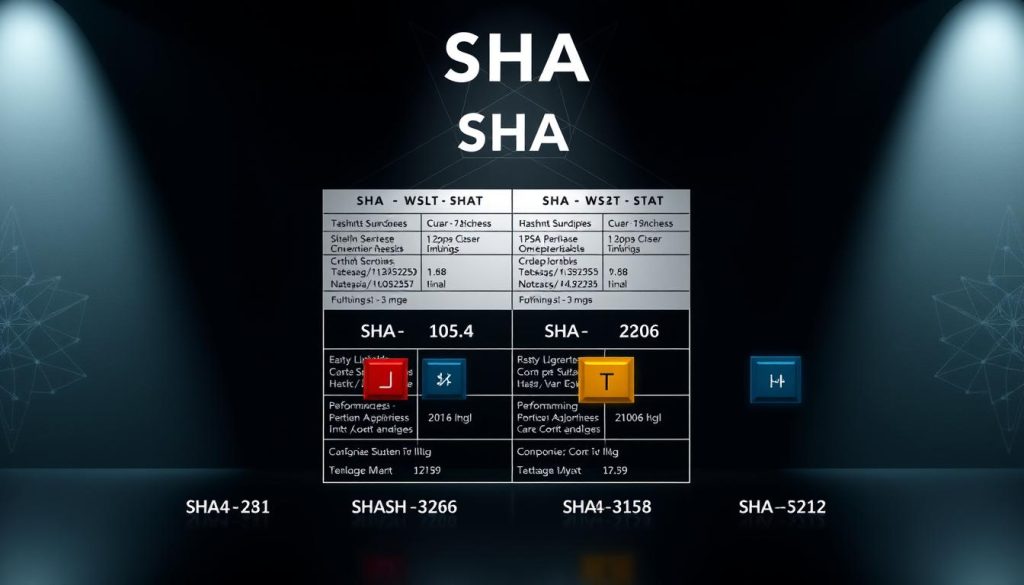Can a digital fingerprint, created over thirty years ago, still be trusted to protect our information today? This question lies at the heart of understanding the MD5 algorithm, a foundational tool in computer science. We begin our exploration of this influential cryptographic hash function by acknowledging its complex legacy. Developed by Ronald Rivest in 1991, the MD5 hash was designed to produce a unique, fixed-size value from any input data. This 128-bit output acts like a compact digital signature for the original information. The core principle is deterministic: the same input will always generate the identical hash.
While its role in security has diminished due to discovered vulnerabilities, the algorithm remains relevant. It is still widely used for non-cryptographic purposes where speed and simplicity are essential. We will guide you through its technical operation, practical applications, and modern alternatives.
Key Takeaways
- MD5 is a cryptographic hash function that creates a unique 128-bit digital fingerprint from any input data.
- It was developed in the early 1990s as an improvement over previous algorithms.
- The same input will always produce the exact same MD5 hash value.
- While considered cryptographically broken for security, it is still useful for basic data integrity checks.
- Its speed makes it suitable for non-security applications like database partitioning.
- Understanding MD5 provides a foundation for learning about modern hashing techniques.
Historical Evolution and Background of MD5
In the early 1990s, cryptographic experts recognized the need for a more robust hashing solution. Professor Ronald Rivest of MIT collaborated with RSA Data Security, Inc. to develop this improved algorithm. Their work addressed growing concerns about the security of existing hash functions.
From MD4 to MD5: The Transition
The MD4 message-digest algorithm showed potential weaknesses under analytical scrutiny. This prompted Ronald Rivest to design MD5 in 1991 as a secure replacement. The new function incorporated additional rounds and modified operations for better resistance against cryptanalytic attacks.
MD5 was formally published as RFC 1321 in April 1992. This established it as an open standard available to developers worldwide. The MD5 algorithm quickly became one of the most widely implemented hash functions in computing history.
A Timeline of Developments and Key Events
In 1993, researchers discovered a “pseudo-collision” in the MD5 compression function. This finding indicated potential weaknesses in the algorithm‘s design. It marked the first sign of vulnerability in what was considered a secure system.
The critical turning point came in 1996 when Hans Dobbertin announced a full collision. This discovery prompted cryptographers to recommend switching to alternatives like SHA-1. The security community began questioning MD5’s reliability for sensitive data protection.
By 2004, researchers demonstrated practical collision generation in just one hour. Subsequent improvements reduced this time to minutes on consumer hardware. These developments fundamentally undermined confidence in MD5 for security-critical applications.
The timeline culminated with RFC 6151 in 2011, which formally updated security considerations. This document reflected the accumulated knowledge about MD5’s vulnerabilities. It provided official guidance recommending caution in the algorithm’s continued use.
How the MD5 Hashing Algorithm Works
Processing information through MD5 involves breaking it into standardized blocks for consistent handling. The algorithm accepts any input length but always generates a fixed 128-bit hash value. This transformation occurs through meticulous mathematical procedures.
Message Processing and Padding Techniques
Before computation begins, the system prepares the message. It divides the data into 512-bit blocks. Padding ensures the final length aligns perfectly with this requirement.
A single “1” bit appends to the original content. Zero bits follow until 64 bits remain in the block. These final bits store the original message length in binary form.
Operational Rounds and Bitwise Functions
The core function uses four 32-bit buffers (A, B, C, D) initialized with specific constants. Sixty-four operations process each block across four rounds. Each round applies a unique bitwise function.
Round one uses F=(B AND C) OR ((NOT B) AND D). Round two employs G=(D AND B) OR ((NOT D) AND C). The third round applies H=B XOR C XOR D. Final round uses I=C XOR (B OR (NOT D)).
Every operation incorporates a message block, a constant, and left rotation. Modular addition ensures mathematical consistency. This intricate process creates the distinctive MD5 hashing algorithm output.
Understanding this foundation helps appreciate why developers now prefer alternatives like the Secure Hash Algorithm for enhanced security.
Deep Dive: What is md5 and Its Functional Role
The practical value of MD5 extends far beyond its original cryptographic purpose into fundamental data verification. We now explore how this algorithm serves critical functions in maintaining information reliability.
MD5’s Role in Data Verification and Integrity
MD5 operates as a digital checksum system for confirming data integrity. The algorithm generates a unique hash value that acts like a fingerprint for any file or message. This allows users to verify content remains unchanged from its original state.
Software distributors commonly provide pre-computed MD5 checksums with downloadable files. Users can independently calculate their file’s md5 hash and compare it to the published value. This simple verification process confirms successful, uncorrupted downloads.
Different operating systems include built-in tools for this hashing function. Unix systems feature md5sum utilities, while Windows offers PowerShell commands. These tools make integrity checking accessible across platforms.
The algorithm effectively detects unintentional corruption through its avalanche effect. Even minor changes create completely different hash values. This makes MD5 ideal for identifying transmission errors or storage issues.
Beyond file verification, MD5 serves important roles in legal document management and database systems. Law firms use these checksum identifiers for electronic discovery, while databases employ the algorithm for efficient partitioning. For those seeking deeper technical understanding, our MD5 algorithm tutorial provides comprehensive coverage.
These applications demonstrate MD5’s continued relevance for non-security functions. The distinction between accidental corruption detection and intentional tampering prevention remains crucial for proper implementation.
Security Vulnerabilities and Collision Attacks
Modern computing power has exposed critical weaknesses in MD5 that were unimaginable when the algorithm was first developed. These vulnerabilities fundamentally undermine its reliability for security applications.
Notable Collision Incidents and Their Impact
In 2008, researchers demonstrated a devastating collision attack at the Chaos Communication Congress. They created a rogue certificate authority certificate that appeared legitimate when verified by its MD5 hash.
The 2012 Flame malware incident exploited these weaknesses to forge Microsoft code-signing certificates. This allowed malicious software to bypass security checks by appearing legitimately signed.
These incidents proved that MD5 fails a core requirement of cryptographic hash functions. Attackers can find different inputs producing identical outputs.
Limitations and Vulnerability to Length Extension Attacks
MD5’s Merkle-Damgård construction creates additional security risks. The algorithm is susceptible to length extension attacks where attackers can append data to messages.
Current collision-finding techniques allow specifying arbitrary prefixes. This enables creation of two meaningful files with different content but the same hash value.
Graphics processing units have dramatically accelerated these attacks. Even consumer hardware can compute millions of hashes per second.
Despite these documented vulnerabilities, MD5 remains widely used in legacy systems. Organizations should consider upgrading to more secure alternatives like SHA-256 for critical security applications.
Practical Applications of MD5 in Modern Systems
Beyond security concerns, MD5’s speed and simplicity make it suitable for numerous non-cryptographic applications in contemporary computing. The algorithm continues to serve important functions where cryptographic strength is secondary to efficiency and widespread compatibility.
Checksum and File Integrity Verification
MD5 excels as a checksum tool for verifying file integrity during transfers. Software distributors commonly provide pre-computed MD5 hashes alongside downloadable files. Users can compare these values to confirm their downloads completed without transmission errors.
Different operating systems include built-in tools for this purpose. Unix systems feature md5sum utilities, while Windows offers PowerShell commands. These tools help detect accidental file corruption effectively.
The algorithm’s limitation lies in its vulnerability to intentional tampering. While it reliably identifies transmission errors, MD5 cannot protect against malicious file substitution. Attackers can create different files with identical hash values.
Despite this limitation, MD5 remains valuable for non-security applications. Database systems use it for partitioning, and legal firms employ it for document identification. These practical uses demonstrate the algorithm’s continued relevance in specific contexts.
Alternatives to MD5 in the Age of Advanced Cryptography
As cryptographic standards evolve, organizations face critical decisions about migrating from vulnerable hash functions to more secure alternatives. The security community has developed robust replacements that address MD5’s weaknesses while maintaining performance.
Comparing SHA-2, SHA-3, and Other Secure Algorithms
The SHA-2 family represents the primary replacement for security applications. This group includes SHA-256, SHA-384, and SHA-512 variants with output lengths from 224 to 512 bits. These algorithms provide substantially stronger collision resistance than MD5’s 128-bit output.
SHA-256 has become the most widely adopted variant. It powers blockchain technologies, SSL certificates, and digital signature schemes. The 256-bit output length offers approximately 2^128 security against collision attacks.
For organizations requiring the highest standards, SHA-3 offers an alternative with different internal construction. Based on the Keccak sponge function, it provides resilience against potential future cryptanalytic advances. While SHA-1 served as an interim solution, it now shares MD5’s vulnerability status.
When to Consider Upgrading from MD5
Immediate migration is essential for security-critical applications. This includes password storage, digital signatures, and authentication systems where collision resistance matters most.
U.S. government applications now mandate SHA-2 family hash functions as the minimum standard. Organizations should prioritize upgrades based on security sensitivity while recognizing that non-cryptographic uses may continue using MD5 where performance advantages provide value without creating risks.
Conclusion
Our exploration of cryptographic hashing brings us to a pivotal conclusion about MD5’s proper role in modern computing. This message-digest algorithm revolutionized data verification when introduced, but its security limitations now demand careful consideration.
The hash function remains valuable for non-critical applications like file integrity checks. However, we must avoid using it for password storage or digital signatures where collision resistance matters.
Modern alternatives like SHA-256 provide stronger security for sensitive data. Organizations should audit their systems and prioritize migrating away from MD5 where protection against intentional tampering is essential.
Understanding this balance helps technology professionals make informed decisions. The algorithm‘s legacy teaches important lessons about cryptographic evolution and responsible implementation.
FAQ
What is the primary purpose of the MD5 algorithm today?
Why is MD5 considered insecure for password storage?
Can you explain what a hash function collision is?
What are some common applications where MD5 is still used?
What are the main alternatives to MD5 for secure hashing?
How does a length extension attack work against MD5?
Who created the MD5 algorithm and when?
Cathy is a senior blogger and editor in chief at text-center.com.



